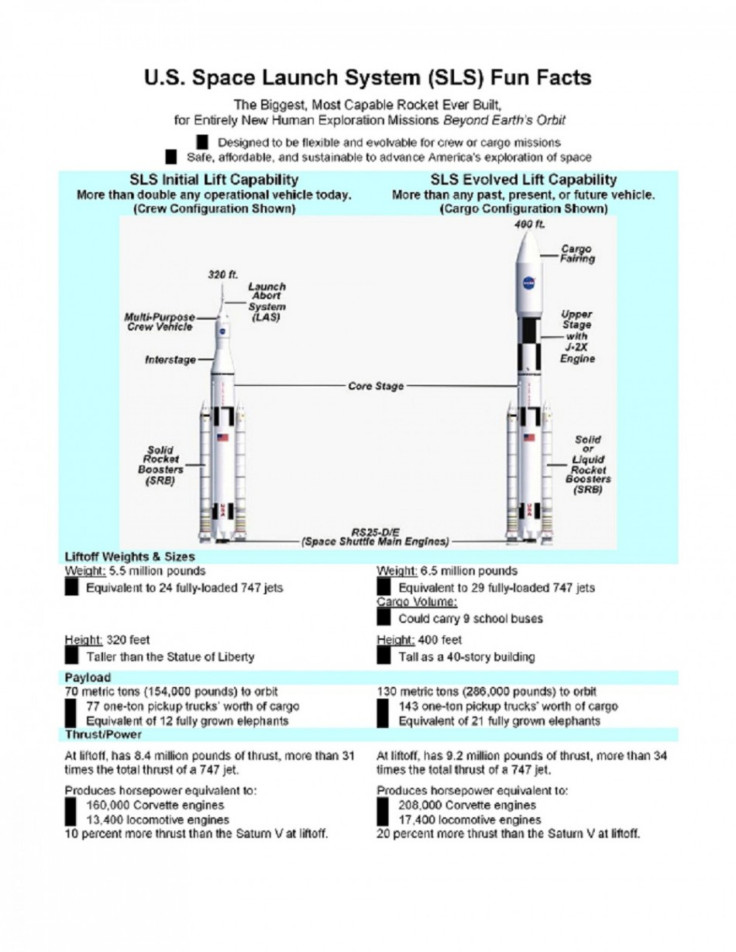NASA Plans to Build World's Largest Rocket (VIDEO)

NASA wants to build a 320-foot Space Launch System that would be the world's largest and most powerful rocket, aiming to fly humans to nearby asteroids around 2025 and Mars in the 2030s.
The SLS would be a significant step toward reviving the U.S. space program at a time when NASA is suffering job losses and has seemed aimless after the space shuttle's retirement.
The SLS will be designed to carry the Orion Multi-Purpose Crew Vehicle, as well as important cargo, equipment and science experiments to Earth's orbit and destinations beyond. The shuttle could carry about 50,000 pounds of cargo into low-Earth orbit. The new rocket will be able to initially lift as much as 140,000 pounds of cargo and power it well beyond low-Earth orbit.
In essence, the rocket will look like an Apollo-era capsule atop the tallest of three giant boosters, much in configuration like the external tank and two boosters that the shuttle rode into space.
The SLS, which will be NASA's first exploration-class vehicle since the Saturn V took American astronauts to the moon 40 years ago, also would serve as a backup for commercial and international partner transportation services to the International Space Station.
While I was proud to fly on the space shuttle, tomorrow's explorers will now dream of one day walking on Mars, NASA Administrator Charles Bolden said in a statement.
The rocket would use a liquid hydrogen and liquid oxygen propulsion system, which will include the RS-25D/E from the space shuttle program for the core stage and the J-2X engine for the upper stage.
The SLS, which will have an initial lift capacity of 70 metric tons, will also use solid rocket boosters for the initial development flights, while follow-on boosters will be competed based on performance requirements and affordability considerations.
The lift capacity will be evolvable to 130 metric tons -- more than 286,000 pounds, or 143 tons -- enough to lift 75 SUVs. The first developmental flight, or mission, is targeted for the end of 2017.
NASA has selected the specific architecture due to its flexibility, which allows NASA to address high-cost development activities early on in the program and take advantage of higher buying power before inflation erodes the available funding of a fixed budget.
In addition, this architecture provides a modular launch vehicle that can be configured for specific mission needs using a variation of common elements.
This architecture also enables NASA to leverage existing capabilities and lower development costs by using liquid hydrogen and liquid oxygen for both the core and upper stages.
The cost of getting the heavy-lift rocket and capsule ready to fly within no more than five years will be around $18 billion, or well under figures recently cited by critics of a NASA-led deep space exploration effort. The estimated five-year price tag for the giant rocket is $10 billion, $6 billion for the capsule and $2 billion for the launch site at Kennedy Space Center in Florida, officials said.
We have been driving down the costs on the Space Launch System and Orion contracts by adopting new ways of doing business and project hundreds of millions of dollars of savings each year, said NASA Deputy Administrator Lori Garver.
Watch the below video for an animation of the World's most powerful rocket:
© Copyright IBTimes 2024. All rights reserved.





















